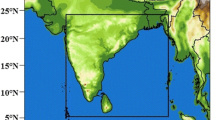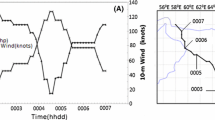Abstract
The Weather Research and Forecasting model (WRF) is configured for the region of (15°–41°N, 105°–135°E), which covers the same area with the MASNUM (Key Lab. Marine Science & Numerical Modeling, State Oceanic Administration) wave-tide-circulation coupled operational forecast system. Three numerical experiments are implemented to investigate the effects of the real-time forecasted sea surface temperature (SST) and the non-breaking wave-induced vertical mixing (Bv) on the track forecast of all 33 tropical cyclones (TC) in the model domain area during 2008 and 2011. The first experiment employs NCEP FNL (NCEP final analysis) SST as WRF’s bottom condition as the Control run, which is also the default setup of WRF. The second and third experiments use real-time forecasted SST from the MASNUM forecast system with and without Bv, respectively. The forecasted track results are compared with Japan Meteorological Agency’s best track data. For 24-h forecast, the averaged TC position error of Experiment with Bv is reduced by 9 % compared to the Control experiment, while the forecasted track error of Experiment without Bv is reduced by only 2 % compared to the Control experiment. For the 48-h forecast, the averaged track errors are reduced by 10 % and 6 % with Bv and without Bv compared to the Control experiment, respectively. These results suggest that the real-time forecasted SST can improve the performance of WRF in forecasting TC track, and the Bv plays an important role in reducing the forecast error of TC track. Comparatively, Bv can improve more on the track of stronger TC.








Similar content being viewed by others
References
Holland GJ (1983) Tropical cyclone motion, environmental interaction plus a beta effect. J Atmos Sci 40:328–342
Dengler K (1997) A numerical study of the effects of land proximity and changes in sea surface on hurricane tracks. Q J Roy Meteor Soc 123:1307–1322. doi:10.1002/qj.49712354109
Emanuel K (1986) An air-sea interaction theory for tropical cyclones, Part I: steady-state maintenance. J Atmos Sci 43:585–604
Emanuel K (1995) Sensitivity of tropical cyclones to surface exchange coefficients and a revised steady-state model incorporating eye dynamics. J Atmos Sci 52:3969–3976
Emanuel K (2003) Tropical cyclones. Ann Rev Earth Plan Sci 31:75–104. doi:10.1146/annurev.earth.31.100901.141259
Chen SY, Price JF, Zhao W et al (2007) The CBLAST Hurricane program and the next-generation fully coupled atmosphere-wave-ocean models for hurricane research and prediction. Bull Am Meteor Soc 88:311–317. doi:10.1175/bams-88-3-311
Bender MA, Ginis I (2000) Real-case simulations of hurricane-ocean interaction using a high-resolution coupled model, effects on hurricane intensity. Mon Wea Rev 128:917–945
Xie LA, Liu B, Liu HQ et al (2011) Numerical simulation of tropical cyclone intensity using an air-sea-wave coupled prediction system. Mon Weather Rev 139:19–43
Doyle JD (2002) Coupled atmospher–ocean wave simulations under high wind conditions. Mon Weather Rev 130:3087–3099
Bao JW, Wilczak JM, Choi JK et al (2000) Numerical simulations of sea-air interaction under high wind conditions using a coupled model, A study of hurricane development. Mon Weather Rev 128:2190–2210
Olabarrieta M, John CW, Brandy A et al (2012) Ocean-atmosphere dynamics during Hurricane Ida and Nor’ida, An application of coupled ocean-atmosphere-wave-sediment transport (COAWST) modeling system. Ocean Model 43–44:112–137. doi:10.1016/j.ocemod.2011.12.008
Bender MA, Ginis I, Robert T et al (2007) The operational GFDL coupled hurricane-ocean prediction system and a summary of its performance. Mon Weather Rev 135:3965–3989. doi:10.1175/2007MWR2032.1
Warner JC, Armstrong B, He RY et al (2010) Development of a coupled ocean–atmosphere-wave-sediment transport (COAWST) modeling system. Ocean Model 35:230–244. doi:10.1016/j.ocemod.2010.07.010
Zhao B, Qiao FL, Wang GS (2012) Impacts of SST on the track and intensity of typhoon JANGMI. Acta Meteor Sin 34:41–52 (in Chinese)
Childs P, Sethu R, Ryan B (2007) High-resolution numerical simulations of Hurricane Isabel (2003) over North Carolina. Nat Hazards 41:401–411. doi:10.1007/s11069-006-9050-9
Bongirwar V, Rakesh V, Kishtawal CM et al (2011) Impact of satellite observed microwave SST on the simulation of tropical cyclones. Nat Hazards 58:929–944. doi:10.1007/s11069-010-9699-y
Wang W, Barker D, Bray J et al (2013) ARW Version 3 Modeling System User’s Guide. http://www.mmm.ucar.edu/wrf/users/docs/user_guide/ARWUsersGuide.pdf
Qiao FL, Yuan YL, Yang YZ et al (2004) Wave-induced mixing in the upper ocean, distribution and application to a global ocean circulation model. Geophys Res Lett 31:L11303. doi:10.1029/2004GL019824
Shu Q, Qiao FL, Song ZY et al (2011) Improvement of MOM4 by including surface wave-induced vertical mixing. Ocean Model 40:42–51. doi:10.1016/j.ocemod.2011.07.005
Qiao FL, Yuan YL, Ezer T et al (2010) A three-dimensional surface wave-ocean circulation coupled model and its initial testing. Ocean Dyn 60:1339–1355. doi:10.1007/s10236-010-0326-y
Wang YG, Qiao FL, Fang GH et al (2010) Application of wave-induced vertical mixing to the K profile parameterization scheme. J Geophys Res 115:C09014. doi:10.1029/2009JC005856
Qiao FL, Huang CJ (2012) Comparison between vertical shear mixing and surface wave-induced mixing in the extratropical ocean. J Geophys Res 117:C00J16. doi:10.1029/2012JC007930
Song YJ, Qiao FL, Song ZY (2012) Improved simulation of the South Asian summer monsoon in a coupled GCM with a more realistic ocean mixed layer. J Atmos Sci 69:1681–1690. doi:10.1175/JAS-D-11-0235.1
Blumberg AF, Mellor GL (1987) A description of a three-dimensional coastal ocean circulation model. In: Heaps N (ed) Three dimensional coastal ocean models, vol 4. AGU, Washington, DC, pp 1–16
Xia CS, Qiao FL, Zhang QH et al (2004) Numerical modeling of the quasi-global ocean circulation based on POM. J Hydrodyn Ser B 16:537–543
Yuan YL, Pan ZD, Hua F et al (1991) LAGFD-WAM numerical wave model-I. Basic physical model. Acta Meteor Sin 10:483–488
Yang YZ, Qiao FL, Zhao W et al (2005) MASNUM ocean wave numerical model in spherical coordinates and its application. Acta Meteor Sin 22:1–7
Xia CS, Qiao FL, Yang YZ et al (2006) Three dimensional structure of the summer time circulation in the Yellow Sea from a wave-tide-circulation coupled model. J Geophys Res 111:C11S03. doi:10.1029/2005JC003218
Wang GS, Qiao FL, Xia CS (2010) Parallelization of a coupled wave circulation model and its application. Ocean Dyn 60:331–339. doi:10.1007/s10236-010-0274-6
Lü XG, Qiao FL, Xia CS et al (2010) Upwelling and surface cold patches in the Yellow Sea in summer, effects of tidal mixing on the vertical circulation. Cont Shelf Res 30:620–632. doi:10.1016/j.csr.2009.09.002
Qiao FL, Wang GS, Lü XG et al (2011) Drift characteristics of green macroalgae in the Yellow Sea in 2008 and 2010. Chin Sci Bull 56:2236–2242. doi:10.1007/s11434-011-4551-7
Qiao FL, Wang GS, Zhao W et al (2011) Predicting the spread of nuclear radiation from the damaged Fukushima nuclear power plant. Chin Sci Bull 56:1890–1896. doi:10.1007/s11434-011-4513-0
Hong SY, Juang HMH, Zhao QY (1998) Implementation of prognostic cloud scheme for a regional spectral model. Mon Weather Rev 126:2621–2639
Dudhia J (1989) Numerical study of convection observed during the winter monsoon experiment using a mesoscale two-dimensional model. J Atmos Sci 46:3077–3107
Mlawer EJ, Taubman SJ, Brown PD et al (1997) Clough, radiative transfer for inhomogeneous atmosphere: RRTM, a validated correlated-k model for the long wave. J Geophys Res 102:16663–16682. doi:10.1029/97JD00237
Kain JS, Fritsch JM (1990) A one-dimensional entraining detraining plume model and its application in convective parameterization. J Atmos Sci 47:2784–2802
Lin YL, Farley RD, Orville HD (1983) Bulk parameterization of the snow field in a cloud model. J Appl Meteor Climatol 22:1065–1092
Chen F, Dudhia J (2001) Coupling an advanced land-surface/hydrology model with the Penn State/NCAR MM5 modeling system. Part I: Model description and implementation. Mon Wea Rev 129:569–585
Acknowledgments
This study is supported by the Public Science and Technology Research Funds Projects of Ocean (201105019).
Author information
Authors and Affiliations
Corresponding author
About this article
Cite this article
Zhao, B., Qiao, F. & Wang, G. The effects of the non-breaking surface wave-induced vertical mixing on the forecast of tropical cyclone tracks. Chin. Sci. Bull. 59, 3075–3084 (2014). https://doi.org/10.1007/s11434-014-0255-0
Received:
Accepted:
Published:
Issue Date:
DOI: https://doi.org/10.1007/s11434-014-0255-0




